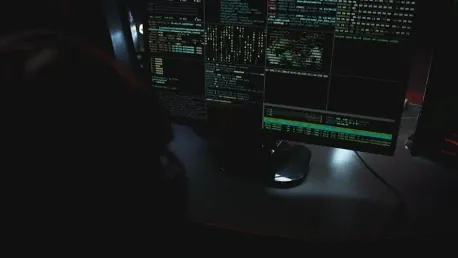In today’s interconnected world, the security of software supply chains has become a critical concern, especially for sectors such as healthcare, education, and government services. A recent study by BlackBerry Limited sheds light on the significant cybersecurity vulnerabilities within these supply chains in the UK public sector, revealing some alarming trends. This in-depth research highlights the frequent cyber-attacks and identified vulnerabilities experienced by over half of the UK IT decision-makers in the past year, raising concerns about the effectiveness of current security measures in protecting sensitive data and maintaining operational continuity.
Rising Cybersecurity Threats
Increased Attacks on Critical Infrastructure
Attacks on critical infrastructure are becoming increasingly common, adding substantial stress to organizations within the healthcare, education, and government sectors. The survey of 200 IT decision-makers and cybersecurity leaders found that these sectors face a consistent barrage of cyber threats. With 71% experiencing financial loss, 67% suffering data loss, and 67% facing reputational damage, the impact of these attacks extends far beyond mere inconvenience. Operational disruption was reported by 50% of respondents, while 38% disclosed losses of intellectual property. Such attacks can have crippling effects, potentially jeopardizing vital services and public trust.
The main vulnerabilities identified were rooted in operating systems (38%) and web browsers (17%), highlighting the pervasive weak points in software ecosystems. Despite investing in rigorous security measures such as data encryption by 51%, staff training by 49%, and multi-factor authentication (34%), the measures seem insufficient against sophisticated cyber threats. The statistics underscore the necessity for a more robust and multi-layered security approach that can effectively safeguard against both internal and external threats.
Software Supply Chain Weaknesses
An area of significant concern is the supply chain’s blind spots, particularly related to the verification of software suppliers’ security claims. The survey disclosed that only 47% of public sector IT decision-makers request evidence of a supplier’s certification and compliance. Even fewer ask for third-party audit reports (38%) or proof of internal security training (32%). These gaps in verification allow potential vulnerabilities to go unchecked, creating entry points for cyber attackers. These blind spots underscore the critical need for improved verification processes to ensure suppliers meet robust security standards.
Surprisingly, more than half of the respondents revealed the discovery of previously unknown participants in their software supply chain over the past 12 months. This revelation points to substantial security lapses, as unmonitored entities can introduce unknown risks. Regular and thorough vetting of all participants in the supply chain is essential to maintaining a secure operational environment. Without such practices, organizations risk exposing themselves to preventable attacks that could severely affect their operations and reputation.
The Need for Enhanced Monitoring
Frequency of Software Inventory Checks
Encouragingly, 15% of IT decision-makers conduct near-real-time software inventory checks, and 28% perform these reviews monthly, ensuring some level of vigilance. However, a notable 39% only carry out this vital process every one to three months, and 18% do it even less frequently. The infrequent monitoring of software inventory leaves substantial windows of opportunity for cyber threats to infiltrate systems unnoticed. Regular and frequent inventory checks are crucial in identifying and addressing vulnerabilities before they can be exploited by malicious actors.
The challenges impeding more frequent monitoring include limited supply chain visibility (53%), lack of technical knowledge (49%), ineffective tools (38%), shortage of skilled personnel (38%), and inadequate funding (21%). Addressing these hindrances requires targeted investments and development of capabilities. Enhancing visibility and technical proficiency, alongside acquiring effective tools, is vital in establishing a resilient defense against ongoing cyber threats. Prioritizing these areas can greatly reduce the time it takes to detect and respond to potential vulnerabilities.
Tools for Improved Visibility
To mitigate these risks, there is a growing demand for tools that can improve software library inventories and bolster visibility regarding vulnerabilities. Modern AI-powered Managed Detection and Response (MDR) technologies offer a promising solution by providing continuous threat coverage and reinforcing confidence in managing security breaches. These advanced tools can help identify emerging threats in real-time, allowing organizations to respond swiftly and effectively. Employing such technologies may require initial investment but can yield significant benefits in terms of enhanced security and reduced operational disruptions.
The integration of AI-powered solutions within the public sector’s cybersecurity infrastructure can also help in tackling the skills shortage issue. Automated and intelligent systems can perform complex analyses and threat detection with minimal human intervention, reducing dependency on skilled personnel. This approach can free up resources and allow IT teams to focus on more strategic tasks, thus improving overall security posture. Investing in these advanced technologies is a crucial step toward securing the public sector’s software supply chains from evolving cyber threats.
Call for Continuous Improvement
Enhancing Verification Processes
In conclusion, while there have been steps taken to address these cybersecurity issues within the UK’s public sector, continuous improvement remains critical. A greater emphasis on constant monitoring, effective tools, and stringent verification of suppliers’ security credentials is essential for mitigating risks. Addressing the existing blind spots in the supply chain verification processes should be a priority to prevent potential vulnerabilities from going unnoticed and unaddressed. This approach will help create a more robust and resilient cybersecurity framework that can withstand the ever-evolving threat landscape.
Public sector organizations must prioritize comprehensive and ongoing verification of all participants in their software supply chains to ensure they maintain high-security standards. Regular engagement with suppliers to review and update security practices can foster a collaborative environment focused on mutual protection. By enhancing these processes, IT decision-makers can significantly reduce the risks posed by undiscovered vulnerabilities, ultimately safeguarding critical infrastructure and public trust.
Leveraging Advanced Technologies
In our interconnected world, the security of software supply chains has become paramount, especially in critical sectors such as healthcare, education, and government services. BlackBerry Limited’s recent study has illuminated serious cybersecurity vulnerabilities that plague these supply chains, with a specific focus on the UK public sector. Their extensive research uncovers troubling trends, demonstrating that over half of UK IT decision-makers have faced frequent cyber-attacks and identified numerous vulnerabilities over the past year. This raises serious concerns regarding the effectiveness of existing security protocols in safeguarding sensitive data and ensuring operational continuity. The findings highlight the pressing need for enhanced protective measures, as the current systems appear inadequate for mitigating the risks associated with cyber threats. As cyber-attacks become more sophisticated, improving the security of software supply chains is essential to protect vital infrastructure and maintain the integrity of crucial services. Addressing these vulnerabilities is critical to ensuring data security and the smooth running of essential services.









